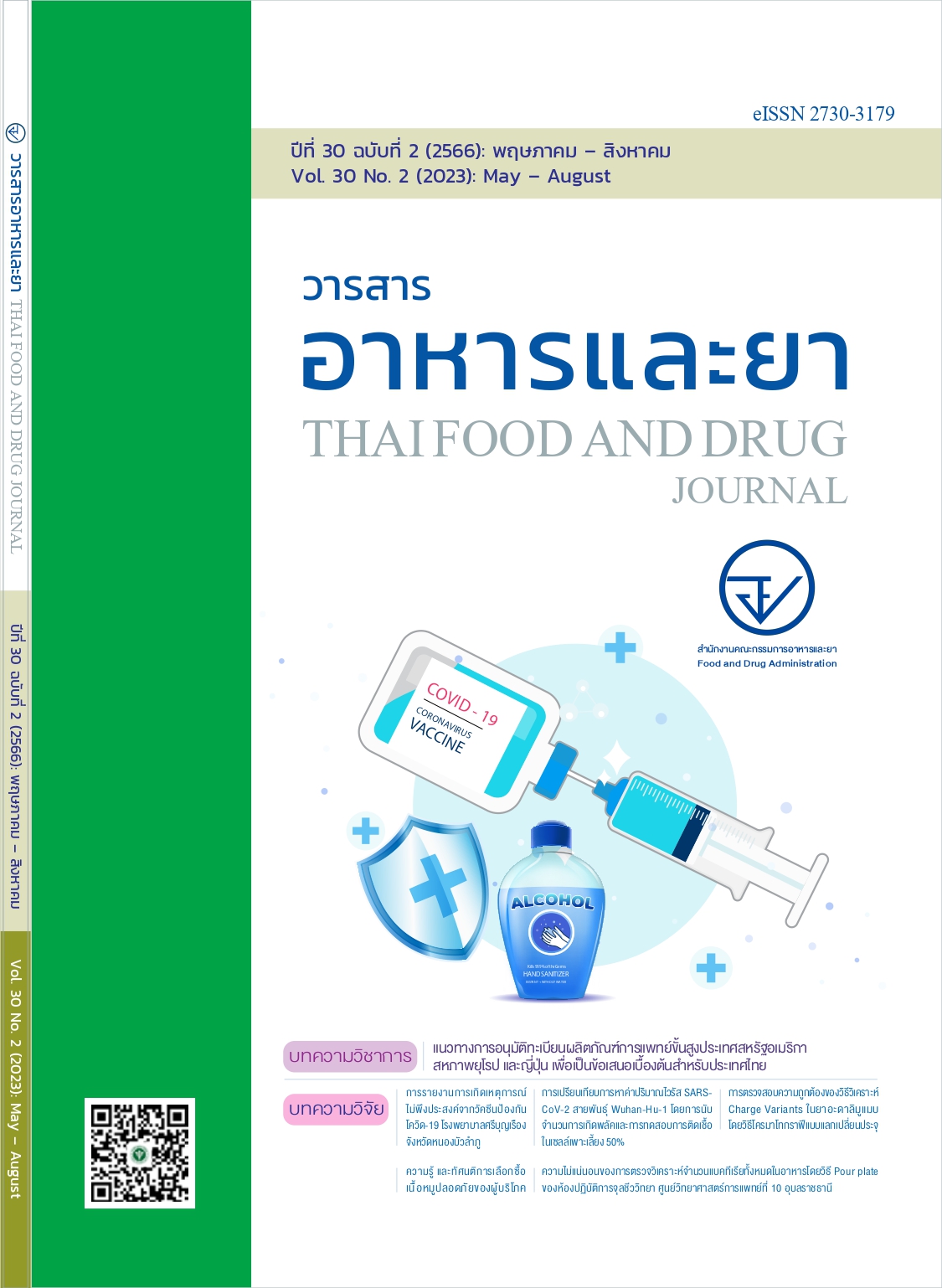การรายงานการเกิดเหตุการณ์ไม่พึงประสงค์จากวัคซีนป้องกันโควิด-19 โรงพยาบาลศรีบุญเรือง จังหวัดหนองบัวลำภู
Main Article Content
บทคัดย่อ
ความสำคัญ: สถานการณ์โควิด-19 ที่ระบาดมากขึ้นส่งผลให้มีการกระตุ้นให้ฉีดวัคซีนป้องกันมากขึ้นตาม ซึ่งวัคซีนที่ใช้เหล่านี้ มีการพัฒนาผลิตอย่างเร่งด่วน ยังมีข้อมูลจำกัด ทั้งยังขาดข้อมูลการใช้ในเวชปฏิบัติ โดยเฉพาะประเทศไทย รวมถึงข้อมูลเหตุการณ์ไม่พึงประสงค์ที่มี มีเฉพาะข้อมูลจากทางผู้ผลิตเท่านั้น คณะผู้วิจัยจึงมองเห็นประโยชน์ของข้อมูลเหตุการณ์ไม่พึงประสงค์ที่พบจากวัคซีนแต่ละชนิด เพื่อการเฝ้าระวัง และป้องกัน
วัตถุประสงค์: เพื่อศึกษาความชุก และลักษณะของเหตุการณ์ไม่พึงประสงค์ที่เกิดขึ้นหลังได้รับวัคซีนป้องกันเชื้อโควิด-19
วิธีวิจัย: การวิจัยนี้เป็นการศึกษาเชิงพรรณนาแบบตัดขวาง ตั้งแต่วันที่ 1 มิถุนายน - 1 ธันวาคม 2564 โดยใช้ข้อมูลเหตุการณ์ไม่พึงประสงค์ที่บันทึกจากฐานข้อมูลระบบสารสนเทศงานบริการตรวจรักษาผู้ป่วย (ระบบ HOSxP) ของโรงพยาบาลศรีบุญเรือง มาวิเคราะห์โดยแจกแจงข้อมูลเป็นความถี่ และร้อยละ
ผลการศึกษา: จากผู้เข้ารับบริการทั้งหมดจำนวน 82,349 โดส พบว่าหลังเข้ารับบริการฉีดวัคซีนพบเหตุการณ์ไม่พึงประสงค์ทั้งหมด 646 ราย เมื่อคำนวณความชุกพบว่า 784.47 เหตุการณ์ต่อ 100,000 โดส โดยวัคซีนที่พบมากที่สุดได้แก่ Astrazeneca® ความชุกของเหตุการณ์ไม่พึงประสงค์เป็น 843.39 เหตุการณ์ต่อ 100,000 โดส พบเหตุการณ์ไม่พึงประสงค์ทั้งหมด 646 เหตุการณ์ เป็นเหตุการณ์รุนแรงทั้งหมด 37 ราย สัมพันธ์กับวัคซีน Coronavac® จำนวน 19 ราย (51.3%) Astrazeneca® 16 ราย (43.2%) และ ComirnatyTM จำนวน 2 (5.4%) โดยพบเสียชีวิตจำนวน 2 ราย โดยจากอาการ Acute liver failure สัมพันธ์กับวัคซีน Astrazeneca® 1 ราย และอาการ Acute leukemia (Severethrombocytopenia) จาก Coronavac® 1 ราย นอกจากนั้นอาการที่พบมากที่สุด Stroke จำนวน 12 ราย จาก Coronavac® 8 ราย (66.7%) และ Aztrazeneca® 4 ราย (33.33%) พบว่าเกิดในเพศหญิง จำนวน 26 ราย รวมถึงพบว่าผู้เข้ารับบริการที่ฉีดเข็มที่ 1 พบอาการรุนแรงที่พบมากกว่าเข็มอื่น ๆ และเหตุการณ์ไม่พึงประสงค์ที่ไม่รุนแรงทั้งหมด 609 เหตุการณ์ ซึ่งพบอาการไม่พึงประสงค์ทั้งหมด 1,251 อาการ โดยพบว่าอาการไม่พึงประสงค์ 10 อันดับแรกที่พบมากที่สุด ได้แก่ วิงเวียนศีรษะ ร้อยละ 11.26 เทียบกับจำนวนอาการทั้งหมด รองลงมาได้แก่ ปวดศีรษะ (9.90) คลื่นไส้ (9.27) ปวดกล้ามเนื้อ (7.75) จุกเสียดแน่นท้อง (7.59) แน่นหน้าอก (6.47) มึนชา (4.48) ไข้ (4.71) ปวดบริเวณฉีด (3.91) และผื่น (3.43) ตามลำดับ
สรุปผล: ความชุกของเหตุการณ์ไม่พึงประสงค์ที่เกิดหลังได้รับวัคซีนโควิด-19 เมื่อเทียบกับปริมาณวัคซีนที่ฉีดพบว่าเกิดน้อย ส่วนใหญ่เป็นเหตุการณ์ไม่พึงประสงค์ชนิดไม่รุนแรงเป็นไปตามที่ระบุในเอกสารกำกับยา อย่างไรก็ตามมีเหตุการณ์ไม่พึงประสงค์รุนแรงแม้จะพบน้อยแต่ก่อให้เกิดอันตรายต่อชีวิต หรือเกิดทุพพลภาพได้ จึงจำเป็นต้องติดตาม เฝ้าระวัง เพื่อป้องกันเหตุการณ์ที่อาจจะเกิดขึ้น
Article Details

อนุญาตภายใต้เงื่อนไข Creative Commons Attribution 4.0 International License.
เอกสารอ้างอิง
กรมควบคุมโรค, กระทรวงสาธารณสุข. รายงานสถานการณ์โรคติดต่อไวรัสโคโรนา 2019 [อินเทอร์เน็ต]. 2564 [เข้าถึงเมื่อ 25 ต.ค. 2564]. เข้าถึงได้จาก:
https://ddc.moph.go.th/viralpneumonia/file/situation/situation-no514-310564.pdf
วิมล สุวรรณเกษาวงษ์, ภควดี ศรีภิรมย์, ปราโมทย์ ตระกูลเพียรกิจ, ชญานิษฐ์ เพ็ชรรัตน์, วรสิทธิ์ ศรศรีวิชัย. การประเมินการใช้ Thai Algorithm สำหรับการติดตามอาการไม่พึงประสงค์จากการใช้ยา. วารสารวิชาการสาธารณสุข 2559; 25(4):673-82.
กรมควบคุมโรค, กองระบาดวิทยา. แนวทางการเฝ้าระวังและสอบสวนเหตุการณ์ไม่พึงประสงค์ภายหลังได้รับวัคซีนป้องกันโรคโควิด-19 (ฉบับปรับปรุงวันที่ 17 มิ.ย. 2564) [อินเทอร์เน็ต]. 2564 [เข้าถึงเมื่อ 25 ต.ค. 2564]. เข้าถึงได้จาก: https://ddc.moph.go.th/viralpneumonia/file/g_srrt/g_srrt_170664.pdf
World Health Organization. Causality assessment of an adverse event following immunization (AEFI): user manual for the revised WHO classification, 2nd ed., 2019 update
[Internet]. 2021 [cited 2021 Oct 25]. Available from: https://www.who.int/publications/i/item/9789241516990
กรมควบคุมโรค. แนวทางปฏิบัติสำหรับอาการไม่พึงประสงค์หลังการได้รับวัคซีนป้องกันโรค กรณีปฏิกิริยาที่สัมพันธ์กับความเครียดจากการฉีดวัคซีน กลุ่มอาการคล้ายภาวะหลอดเลือดสมอง [อินเทอร์เน็ต]. 2564 [เข้าถึงเมื่อ 25 ต.ค.2564]. เข้าถึงได้จาก: https://apps-doe.moph.go.th/boe/software/file/ISRR_25Apr2021.pdf
National Coordinating Council for Medication Error Report and Prevention (NCC MERP). About Medication Errors [Internet]. 2017 [cited 2021 Oct 25]. Available from: http://www.nccmerp.org/about-medication-errors
Public Health Ontario. Adverse Events Following Immunization (AEFIs) for COVID-19 in Ontario [Internet]. 2022 [cited 2021 Oct 25]. Available from: https://www.publichealthontario.ca/-/media/documents/ncov/epi/covid-19-aefi-report.pdf?sc_lang=en
BC Centre for disease Control, Provincial Health Service. British Columbia Report Adverse Events Following Immunization with COVID-19 Vaccines [Internet]. 2022 [cited 2021 Oct 25]. Available from: http://www.bccdc.ca/Documents/COVID19_AEFI_Monthly_Report_2022-11-24.pdf
รุ่งนภา ทรงศิริพันธุ์, สิริวรรณ หวังวโรดม. งานวิจัยเรื่องเหตุการณ์ไม่พึงประสงค์ภายหลังได้รับวัคซีนโควิด-19 ณ โรงพยาบาลหาดใหญ่. ข่าวสารด้านยาผลิตภัณฑ์สุขภาพ 2554;24(4);64-74.
Subedi P, Yadav G. K, Paudel B, Regmi A, Pyakurel P. Adverse events following the first dose of Covishield (ChAdOx1 nCoV-19) vaccination among health workers in selected districts of central and western Nepal: A cross-sectional study. PloS one 2021;16(12).


